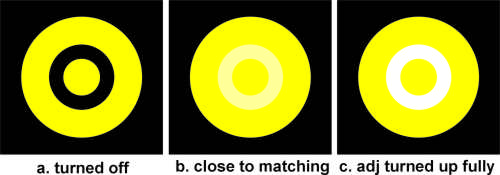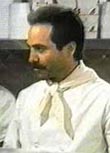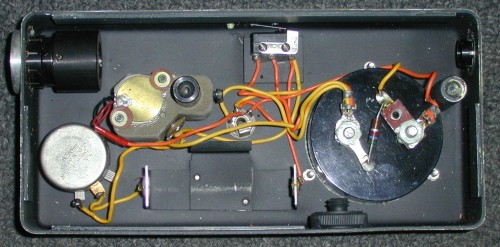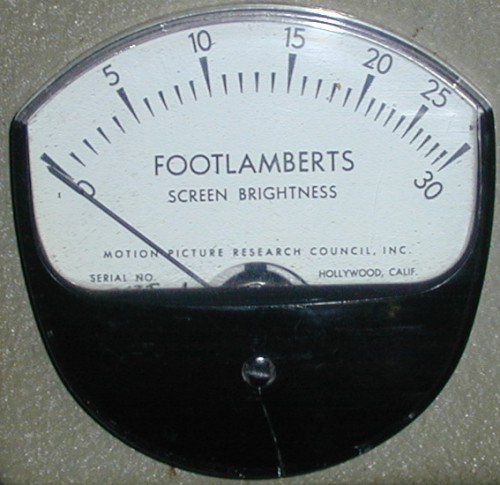|
|
This topic comprises 2 pages: 1 2
|
|
Author
|
Topic: Kollmoorgen light meter, info requested
|
|
|
|
|
|
|
|
|
|
|
John Pytlak
Film God

Posts: 9987
From: Rochester, NY 14650-1922
Registered: Jan 2000
|
 posted 02-17-2003 09:51 AM
posted 02-17-2003 09:51 AM





I wrote an article about screen luminance meters:
http://www.kodak.com/US/en/motion/newsletters/pytlak/june2000.shtml
Using a camera exposure meter can be problematic, as it may not have the necessary visual (photopic) response, be sensitive to the shutter frequency, and not have the precision needed (most are only accurate to within about 1/2 stop).
I've toyed with the idea of using "PHOTOGRAPHIC PHOTOMETRY" to measure screen luminance. Sunlit daylight is a very constant light source for both intensity (about 9000 footcandles when the sun is at a 30-degree elevation) and color temperature (D-5500). So if you expose a color reversal slide film to an 90% white card (sheet of 90 brightness white paper) at an exposure that produces a gray density under specified daylight conditions, you have 0.90 x 9000 = 8100 footlamberts reflected by the card, at a color temperature of D-5500. Now 8100 footlamberts is almost exactly 9-stops more than 16 footlamberts screen luminance specified by SMPTE 196M. So if you expose a sheet of white paper illuminated by daylight with the sun at a 30-degree elevation, then ON THE SAME ROLL OF FILM expose the open-gate lit screen with 9 stops more exposure, the gray images formed on the processed slide film SHOULD CLOSELY MATCH for density and color!
As an example, exposing a sunlit 90 percent white card using KODAK ELITE Chrome 100 film would produce a mid-scale gray at an exposure of 1/500 second at f/16. Exposing an open-gate illuminated movie screen with 16 footlamberts illumination on the same roll of film with 9 stops more exposure (e.g., 1/8 second at f/5.6) should result in a near match.
If I can work out the details, this method would provide a means of checking screen luminance, uniformity, and color temperature by simply using an adjustable camera and a roll of reversal film on a sunny day. ![[Cool]](cool.gif)
| IP: Logged
|
|
|
|
|
|
|
|
|
|
|
|
|
|
|
|
|
|
John Walsh
Film God

Posts: 2490
From: Connecticut, USA, Earth, Milky Way
Registered: Oct 1999
|
 posted 02-28-2005 07:49 PM
posted 02-28-2005 07:49 PM




Hi, Frank... This meter actually belongs to the company I work for. It had an inch of dust on it, so I know no one uses it. I had never seen one before and it took a few minutes to figure it out. When you look through the view finder, you see a ring. The ring is dark when the unit is off. When the momentary button on top is pressed, the ring lights up. The idea is to adjust the pot on the side until the ring matches the "brightness" of the screen area you are viewing. Then, while holding the button down, you look at the meter reading.

I don't think I would trust it for absolute values, but it might be OK for relative 'comparison' use.
| IP: Logged
|
|
|
|
All times are Central (GMT -6:00)
|
This topic comprises 2 pages: 1 2
|
Powered by Infopop Corporation
UBB.classicTM
6.3.1.2
The Film-Tech Forums are designed for various members related to the cinema industry to express their opinions, viewpoints and testimonials on various products, services and events based upon speculation, personal knowledge and factual information through use, therefore all views represented here allow no liability upon the publishers of this web site and the owners of said views assume no liability for any ill will resulting from these postings. The posts made here are for educational as well as entertainment purposes and as such anyone viewing this portion of the website must accept these views as statements of the author of that opinion
and agrees to release the authors from any and all liability.
|

 Home
Home
 Products
Products
 Store
Store
 Forum
Forum
 Warehouse
Warehouse
 Contact Us
Contact Us




 Printer-friendly view of this topic
Printer-friendly view of this topic








![[Cool]](cool.gif)










